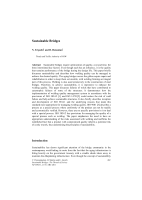Bridges

Sustainable bridges require optimization of quality, cost and time, the three interrelated key factors. Even though each has an influence, it is the quality that sustains performance of the bridge during the design life. This paper briefly discusses sustainability and describes how welding quality can be managed to achieve the desired quality. The aging bridges across the globe require repair and rehabilitation in order to keep them serviceable, with welding forming an integral part of this process. Welding is also used extensively in the construction of steel bridges. Therefore, to achieve sustainability, it is imperative to enhance the welding quality. This paper discusses failures of welds that have contributed to catastrophic failures of some of the structures. It demonstrates how the implementation of welding quality management system in accordance with the provisions of ISO 3834.2 [1] and ISO 14731[2] could reduce the risk of weld failure and help achieve sustainable structures. It also briefly describes inception and development of ISO 3834.1 and the underlying reasons that make this standard more appropriate for managing welding quality. ISO 9001 [3] describes a process as a special process where conformity of the product can not be readily and economically verified. However, there are no specific provisions in it to deal with a special process. ISO 3834.2 has provisions for managing the quality of a special process such as welding. The paper emphasises the need to have an appropriate understanding of the risks associated with welding and reaffirms the established fact that a product with compromised quality inherits a potential risk of costly rework, thus undermining the principles of sustainability.
